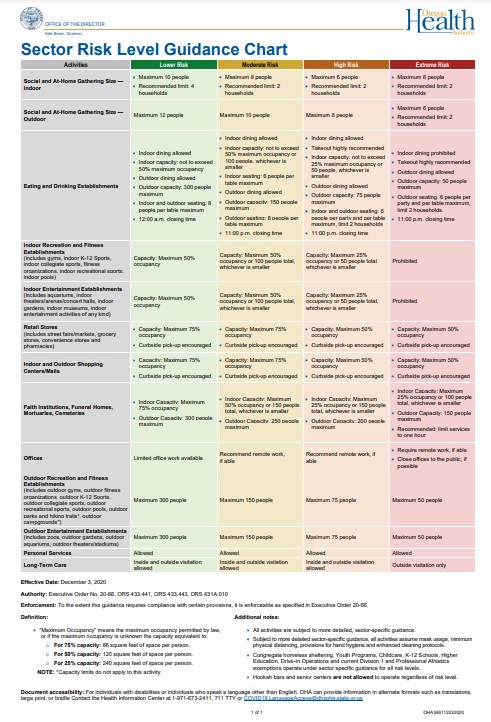(Salem, OR) — Governor Kate Brown today announced updates to county risk levels under the state’s public health framework to reduce transmission and protect Oregonians from COVID-19. The framework uses four different risk levels for counties based on COVID-19 spread—Extreme Risk, High Risk, Moderate Risk, and Lower Risk—and assigns health and safety measures for each level.
Effective March 26 through April 8, there will be two counties in the Extreme Risk level, six at High Risk, 14 at Moderate Risk, and 14 at Lower Risk.
Here is the complete list of counties and their associated risk levels (3/26/21 – 4/8/21):
County Risk Categories, Effective March 26 – April 8
(Data as of March 20, 2021)
Changes from Previous Two-Week Period are Marked in Green and Red
Lower Risk (14)
Baker (Moved from Moderate)
Crook
Gilliam
Harney
Hood River
Jefferson (Moved from High)
Lake
Lane (Moved from Moderate)
Morrow
Sherman
Wallowa
Wasco
Wheeler
Yamhill (Moved from Moderate)
Moderate Risk (14)
Clackamas
Clatsop (Moved from Lower)
Columbia (Moved from High)
Deschutes
Grant (Moved from Lower)
Klamath*
Lincoln (Moved from Lower)
Linn
Malheur
Multnomah
Polk (Moved from High)
Tillamook
Union
Washington
High Risk (6)
Benton
Douglas (Moved from Extreme)
Jackson
Josephine**
Marion
Umatilla
Extreme Risk (2)
Coos
Curry (Moved from High)
*Klamath County qualifies for High Risk but is given a two-week caution period at Moderate Risk because it moved down from High Risk in the last movement period.
**Josephine County qualifies for Extreme Risk but is given a two-week caution period at High Risk because it moved down from Extreme Risk in the last movement period.
“This week we continue to see the majority of counties at Lower and Moderate Risk, and I want to thank Oregonians once again for making smart choices throughout this pandemic,” said Governor Brown. “As we work to open up vaccine eligibility to all Oregonians by May 1, we are seeing the light at the end of the tunnel get a little brighter. But, we still have more work to do to reach the level of community-wide protection we need. I encourage all Oregonians to keep wearing your masks, maintain physical distance, stay home when sick, and get your vaccine when it’s available to you.”
Josephine and Klamath Counties enter Two-Week Caution Period
The recently announced two-week caution period applies to counties facing backward movement. Beginning this week and continuing until further notice, counties that reduced their COVID-19 spread enough to move down in risk level in the previous two-week period, but see their numbers go back up in the next two-week period, will be given a two-week caution period to bring COVID-19 case rates back down again.
This week, the caution period applies to two counties:
- Josephine County qualifies for Extreme Risk but is given a two-week caution period at High Risk because it moved down from Extreme Risk in the last movement period.
- Klamath County qualifies for High Risk but is given a two-week caution period at Moderate Risk because it moved down from High Risk in the last movement period.
The caution period will allow counties to re-focus efforts to drive back down creeping case numbers, and give local businesses additional certainty on their plans for operating. If, at the end of the caution period, case rate data still puts the county at a higher risk level, the county will move to that level.
The Oregon Health Authority will examine and publish county data weekly. County risk levels will be reassigned every two weeks. The first week’s data will provide a “warning week” to prepare counties for potential risk level changes. The next assignment of risk levels will be announced April 6 and take effect April 9.
Updates to Warning Week data and county risk levels will be posted to coronavirus.oregon.gov.



